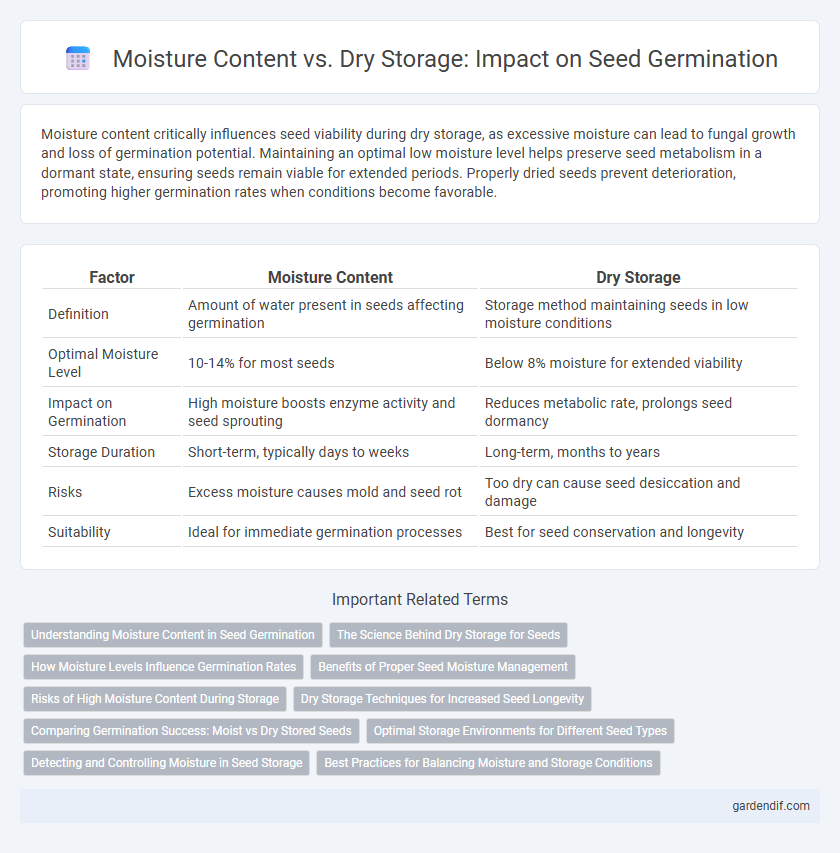
Moisture Content vs Dry Storage Illustration
Moisture content critically influences seed viability during dry storage, as excessive moisture can lead to fungal growth and loss of germination potential. Maintaining an optimal low moisture level helps preserve seed metabolism in a dormant state, ensuring seeds remain viable for extended periods. Properly dried seeds prevent deterioration, promoting higher germination rates when conditions become favorable.
Table of Comparison
| Factor | Moisture Content | Dry Storage |
|---|---|---|
| Definition | Amount of water present in seeds affecting germination | Storage method maintaining seeds in low moisture conditions |
| Optimal Moisture Level | 10-14% for most seeds | Below 8% moisture for extended viability |
| Impact on Germination | High moisture boosts enzyme activity and seed sprouting | Reduces metabolic rate, prolongs seed dormancy |
| Storage Duration | Short-term, typically days to weeks | Long-term, months to years |
| Risks | Excess moisture causes mold and seed rot | Too dry can cause seed desiccation and damage |
| Suitability | Ideal for immediate germination processes | Best for seed conservation and longevity |
Understanding Moisture Content in Seed Germination
Moisture content plays a critical role in seed germination by influencing metabolic activity and enzyme function necessary for embryo development. Seeds with optimal moisture levels maintain viability during dry storage by preventing premature germination and reducing fungal growth risks. Controlling moisture content within 8-12% ensures effective dry storage conditions, preserving seed quality and enhancing germination rates upon rehydration.
The Science Behind Dry Storage for Seeds
Dry storage preserves seed viability by maintaining low moisture content, which slows metabolic and enzymatic activities, reducing the risk of premature germination and deterioration. Seeds stored at optimal moisture levels below 8-12% experience decreased respiration rates, minimizing cellular damage and extending longevity. This controlled moisture environment prevents fungal growth and oxidative stress, critical factors in preserving seed quality during long-term storage.
How Moisture Levels Influence Germination Rates
Optimal moisture content is crucial for seed germination, as too low moisture levels during dry storage can significantly reduce seed viability and delay germination onset. Seeds stored with moisture content below 10% tend to have slower germination rates due to cellular dehydration and metabolic slowdown. Conversely, maintaining moisture content around 12-14% in storage helps preserve enzyme activity and cellular integrity, promoting higher germination percentages and quicker seedling emergence.
Benefits of Proper Seed Moisture Management
Proper seed moisture management maintains optimal moisture content, enhancing seed viability and extending storage life. Dry storage with controlled low moisture levels reduces metabolic activity and minimizes fungal growth, preserving seed quality. Maintaining moisture content between 8-12% is critical to balance dormancy and prevent seed deterioration during long-term storage.
Risks of High Moisture Content During Storage
High moisture content during storage significantly increases the risk of seed deterioration due to enhanced fungal growth and microbial activity. Elevated moisture levels promote respiration and enzymatic reactions, leading to reduced germination rates and seed viability. Proper drying and maintaining moisture content below 12% are critical to minimizing these storage risks and preserving seed quality.
Dry Storage Techniques for Increased Seed Longevity
Dry storage techniques significantly enhance seed longevity by maintaining optimal moisture content below 8%, which slows metabolic activity and prevents fungal growth. Hermetic sealing and temperature control are critical in preserving seed viability during prolonged storage periods. Properly dried and stored seeds can retain germination capacity for years, ensuring successful future cultivation.
Comparing Germination Success: Moist vs Dry Stored Seeds
Seeds stored in moist conditions generally exhibit higher germination rates compared to dry-stored seeds, as moisture aids enzyme activation necessary for embryo development. Dry storage can prolong seed viability by reducing metabolic activity, but excessively low moisture content may cause cellular damage, decreasing germination success. Optimal moisture content balances preservation with metabolic readiness, ensuring seeds maintain viability and germinate effectively upon planting.
Optimal Storage Environments for Different Seed Types
Maintaining precise moisture content is critical for optimal seed germination, as seeds with high moisture are prone to fungal growth and rapid deterioration during storage. Dry storage conditions, typically below 8% moisture content, extend seed viability by reducing metabolic activity and preventing microbial damage, especially in orthodox seeds such as wheat and corn. Conversely, recalcitrant seeds like cacao require higher moisture retention and controlled humid environments to preserve their germination potential during storage.
Detecting and Controlling Moisture in Seed Storage
Moisture content plays a critical role in seed viability during dry storage, as excess moisture accelerates seed deterioration and fungal growth. Detecting moisture levels using tools like moisture meters or equilibrium relative humidity sensors enables precise control to maintain optimal seed dryness. Implementing controlled storage environments with humidity regulation and desiccants ensures prolonged germination potential and preservation of seed quality.
Best Practices for Balancing Moisture and Storage Conditions
Optimal germination relies on maintaining seed moisture content between 8-12% to prevent deterioration during dry storage. Seeds stored at low moisture levels below 8% risk viability loss, while moisture above 12% increases fungal growth and metabolic activity. Best practices involve balancing seed moisture with controlled temperature and humidity levels, typically storing seeds at 10% moisture content and temperatures below 10degC to maximize longevity and germination rates.
Moisture Content vs Dry Storage Infographic

 gardendif.com
gardendif.com